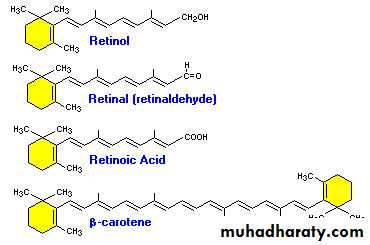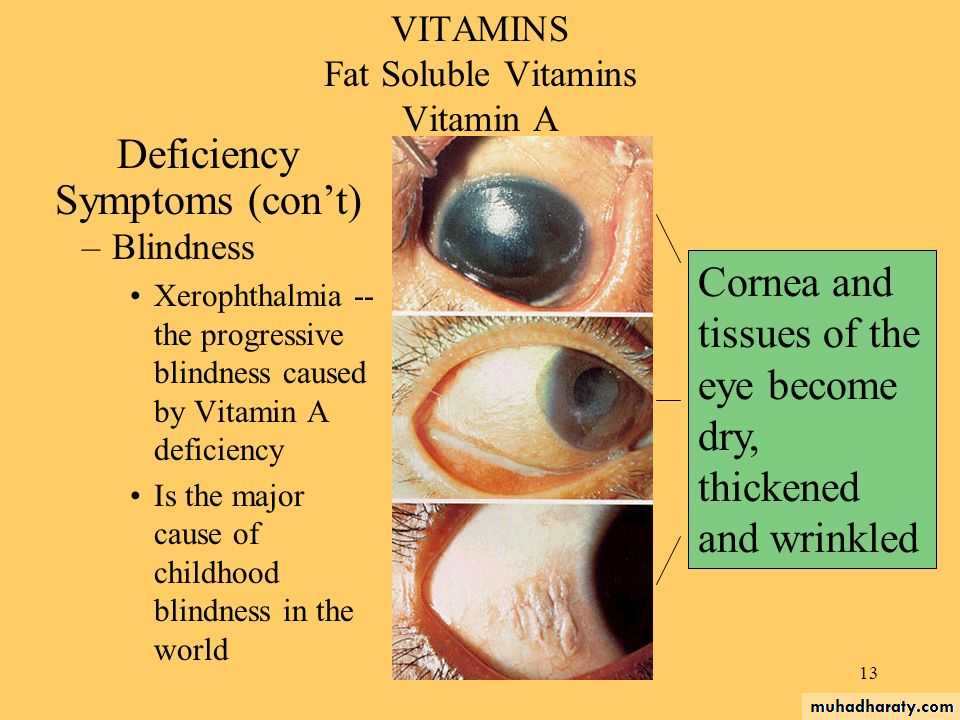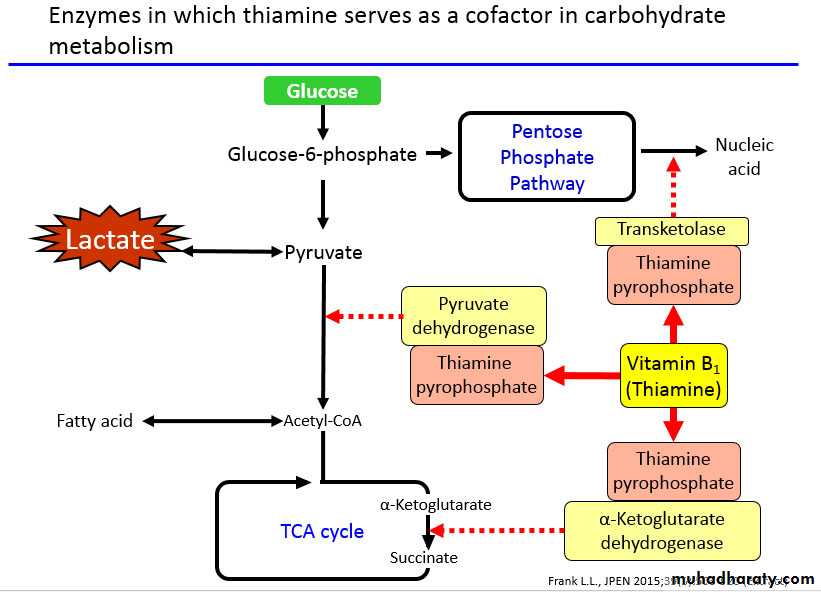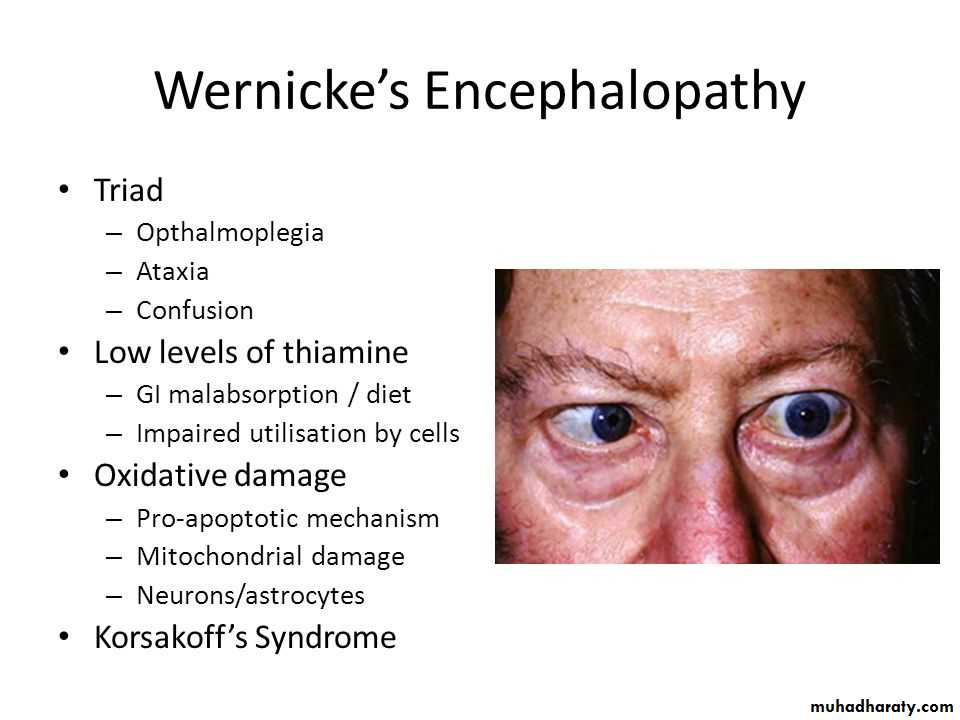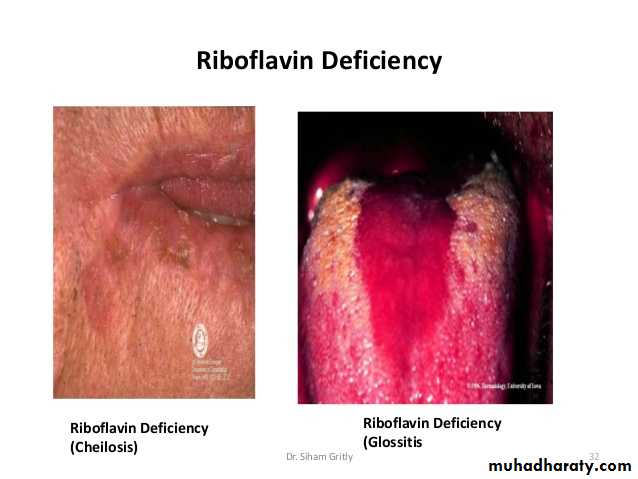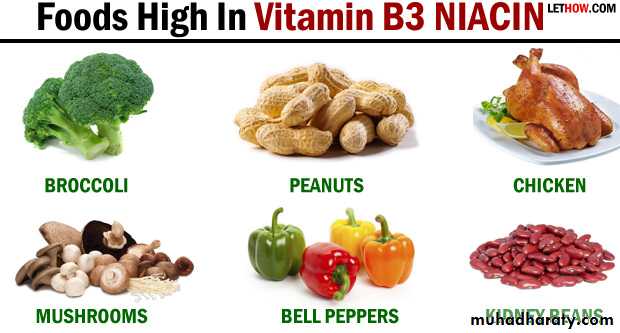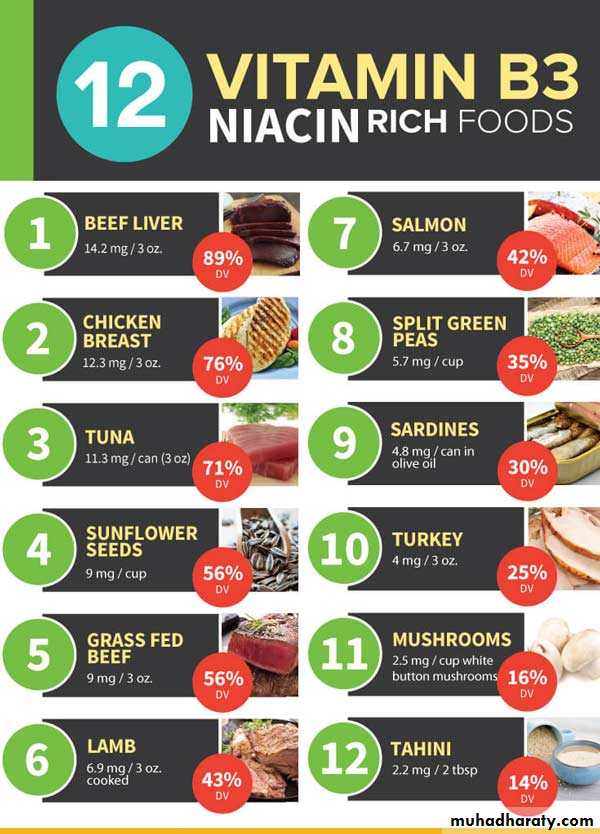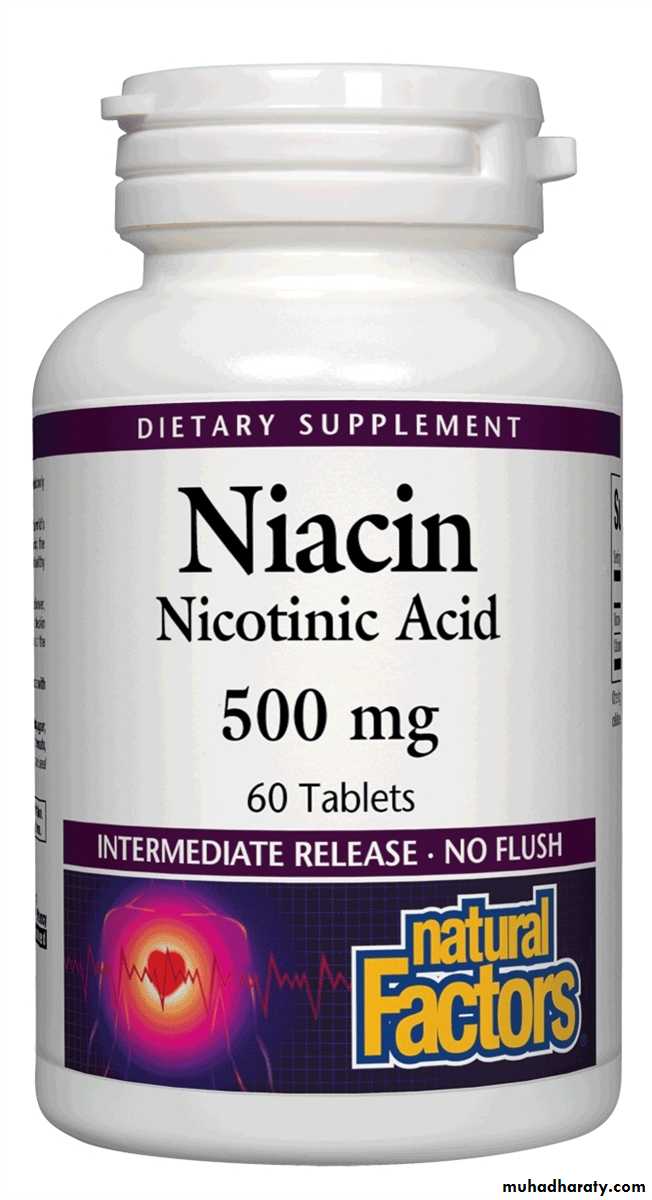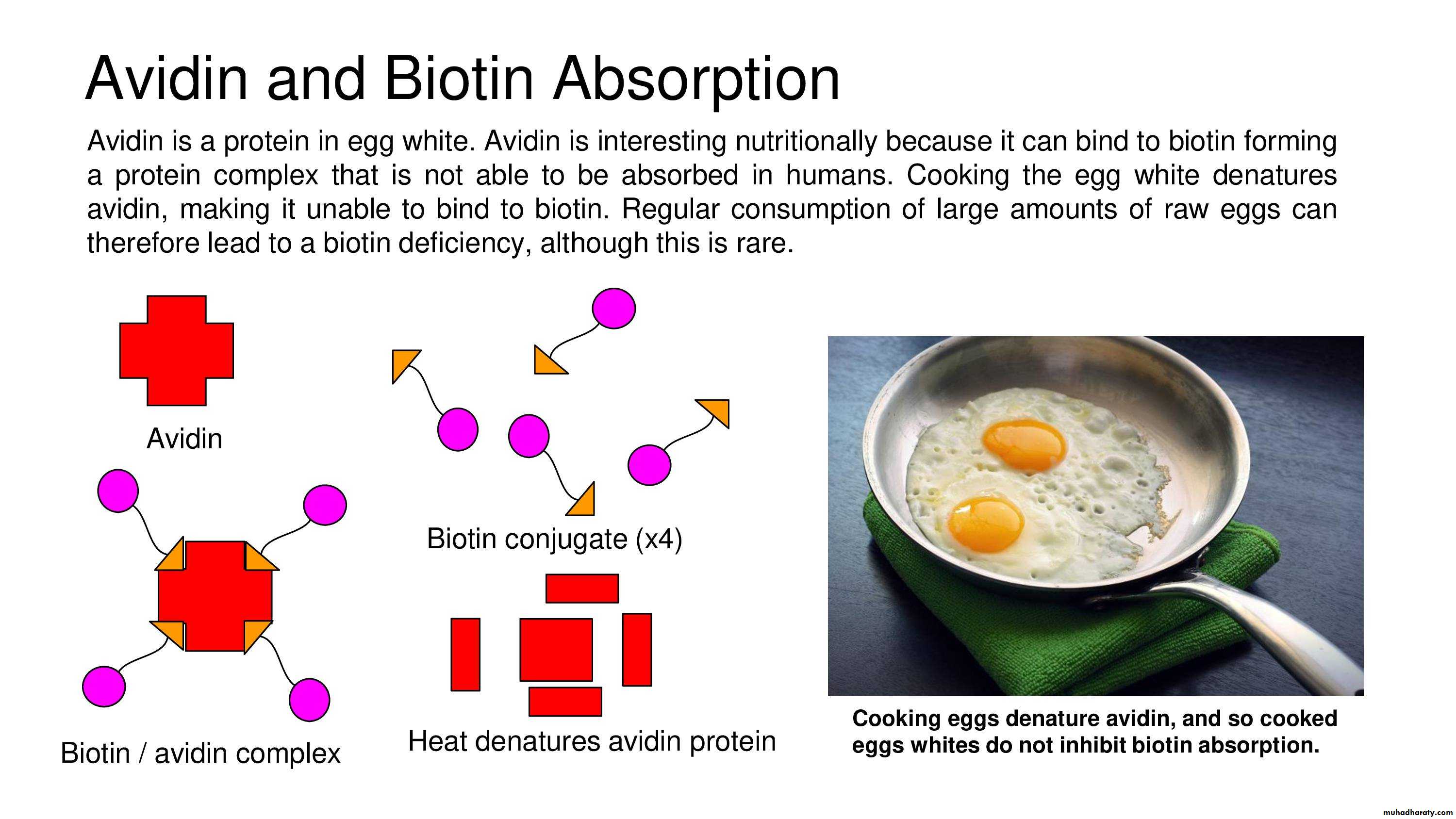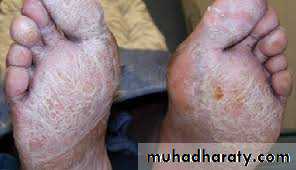L5 5 JAN 2021
الدكتورضياء كاظم الوائلي
شهادة الاختصاص الدقيق في السكري والغدد الصماء
شهادة البورد (الدكتوراه) للامراض الباطنيه والقلبيه والصدريه
عضو الجمعيه الامريكيه للسكري والغدد الصماء
عضو الهيئة التدريسية في كلية الطب - جامعة ذ ي قار
Gastrointestinal disorders that may be associated with malabsorption of fat-soluble vitamins:-
• Biliary obstruction
• Pancreatic exocrine insufficiency
• Coeliac disease
• Ileal inflammation or resection
Vitamin deficiency in old age
• Requirements: although requirements for energy fall with age, those for micronutrients do not. If dietary intake falls, a vitamin-rich diet is required to compensate.• Vitamin D: levels are commonly low due to reduced dietary intake, decreased sun exposure and less efficient skin conversion.
This leads to bone loss and fractures.
Supplements should be given to those at risk of falls in institutional care – the group at highest risk and most likely to benefit.
• Vitamin B12 deficiency: a causal relationship with dementia has not been identified, but it does produce neuropsychiatric effects and should be checked in all those with declining cognitive function.
some vitamins also have pharmacological actions when given at supraphysiological doses, such as the use of vitamin A for acne. Taking vitamin supplements is fashionable in many countries, although there is no evidence of benefit. Toxic effects are most serious with high dosages of vitamins A, B6 and D.
Investigation of suspected vitamin deficiency or excess may involve biochemical assessment of body stores. Measurements in blood should be interpreted carefully, however, in conjunction with the clinical presentation.
Fat-soluble vitamins
Vitamin A (retinol)Pre-formed retinol is found only in foods of animal origin. Vitamin A can also be derived from carotenes, which are present in green and coloured vegetables and some fruits. Carotenes provide most of the total vitamin A in the UK and constitute the only supply in vegans.
Vitamin A does not occur in plants, but many plants contain carotenoids such as beta-carotene that can be converted to vitamin A within the intestine and other tissues.
Retinol is converted to several other important molecules:
1. 11-cis-retinaldehyde is part of the photoreceptor complex in rods of the retina2. Retinoic acid induces differentiation of epithelial cells by binding to specific nuclear receptors, which induce responsive genes. In vitamin A deficiency, mucus-secreting cells are replaced by keratin-producing cells.
3. Retinoids are necessary for normal growth, fetal development, fertility, haematopoiesis and immune function.
• Photoreceptor complex in rods of the retina
• Differentiation of epithelial cells
• Normal growth, fetal development, fertility, haematopoiesis and immune function.
Globally, the most important consequence of vitamin A deficiency is irreversible blindness in young children. Asia is most notably affected and the problem is being addressed through widespread vitamin A supplementation programmes.
Adults are not usually at risk ?????
because liver stores can supply vitamin A when foods containing vitamin A are unavailable.
Early deficiency causes impaired adaptation to the dark (night blindness). Keratinisation of the cornea (xerophthalmia) gives rise to characteristic Bitot’s spots and progresses to keratomalacia, with corneal ulceration, scarring and irreversible blindness .
In countries where vitamin A deficiency is endemic, pregnant women should be advised to eat dark green, leafy vegetables and yellow fruits (to build up stores of retinol in the fetal liver), and infants should be fed the same.
Eye signs of vitamin A deficiency. A. Bitot’s spots in xerophthalmia, showing the white triangular plaques (arrows). B. Keratomalacia in a 14-month-old child. There is liquefactive necrosis affecting the greater part of the cornea, with typical sparing of the superior aspect.
The WHO is according high priority to prevention in communities where xerophthalmia occurs, giving single prophylactic oral doses of 60 mg retinyl palmitate (providing 200 000 U retinol) to pre-school children.
This also reduces mortality from gastroenteritis and respiratory infections.
Repeated moderate or high doses of retinol can cause liver damage, hyperostosis and teratogenicity. Women in countries where deficiency is not endemic are therefore advised not to take vitamin A supplements in pregnancy.
Retinol intake may also be restricted in those at risk of osteoporosis.
Acute overdose leads to nausea and headache, increased intracranial pressure and skin desquamation.
Excessive intake of carotene can cause pigmentation of the skin (hypercarotenosis); this gradually fades when intake is reduced.
Vitamin D
The natural form of vitamin D, cholecalciferol or vitamin D3 , is formed in the skin by the action of ultraviolet (UV) light on 7-dehydrocholesterol, a metabolite of cholesterol. Few foods contain vitamin D naturally and skin exposure to sunlight is the main source.Moving away from the equator, the intensity of UV light decreases, so that at a latitude above 50° (including northern Europe) vitamin D is not synthesised in winter, and even above 30° there is seasonal variation.
The body store accumulated during the summer is consumed during the winter.
Vitamin D is converted in the liver to 25-hydroxyvitamin D (25(OH)D), which is further hydroxylated in the kidneys to 1,25-dihydroxyvitamin D (1,25(OH)2.This 1,25(OH)2D), the active form of the vitamin D activates specific intracellular receptors that influence calcium metabolism, bone mineralisation and tissue differentiation.
The synthetic form, ergocalciferol or vitamin D2 considered to be less potent than endogenous D3
Recommended dietary intakes aim to:-
• Improve musculoskeletal health• Preventing rickets and osteomalacia
• Enhancing muscle strength and reducing the risks of falls in the elderly.
Adequate levels of vitamin D may also be important in non-musculoskeletal conditions and may improve immune function .
Margarines are fortified with vitamin D in the UK, and milk is fortified in some parts of Europe and in North America.
However, the combination of low dietary intake and limited sunlight exposure in the UK has led to recommendations that everyone over the age of 5 should take 10 μg of vitamin D daily.
The individuals at highest risk of vitamin D deficiency are those who have limited exposure to sunshine.
People who are confined indoors, those who habitually cover up their skin when outdoors and those with darker skins should take 10 μg of vitamin D per day all year round. Other groups may require such supplementation only in the winter months of October to March.
Vitamin D metabolism.
Vitamin D is produced in the skin from 7 dehydrocholesterol (7-DHC) by ultraviolet B (UVB) light. The 7-dehydrocholesterol reductase enzyme, which is encoded by the DHCR7 gene, opposes the effect of UVB by converting 7-DHC to cholesterol.The vitamin D then undergoes hydroxylation steps in the liver and kidney to form the active metabolite 1,25(OH)2, which regulates calcium absorption from the diet and bone resorption.
The effects of vitamin D deficiency (calcium deficiency, rickets and osteomalacia) .
An analogue of vitamin D (calcipotriol) is used for treatment of skin conditions such as psoriasis.Excessive doses of cholecalciferol, ergocalciferol or the hydroxylated metabolites cause hypercalcaemia .
There are eight related fat-soluble substances with vitamin E activity. The most important dietary form is α-tocopherol. Vitamin E has many direct metabolic actions:
• It prevents oxidation of polyunsaturated fatty acids(PUFA) in cell membranes by free radicals.
• It helps maintain cell membrane structure.
• It affects DNA synthesis and cell signalling.
• It is involved in the anti-inflammatory and immune systems.
Vitamin E
Human deficiency is rare and has been described only in premature infants and in malabsorption.
It can cause a mild haemolytic anaemia, ataxia and visual scotomas.
Vitamin E intakes of up to 3200 mg/day (1000-fold greater than recommended intakes) are considered safe.
Diets rich in vitamin E are consumed in countries with lower rates of coronary heart disease, although randomised controlled trials have not demonstrated cardioprotective effects of vitamin E or other antioxidants.
Vitamin K
Vitamin K is supplied in the diet mainly as vitamin K1 (phylloquinone) in the UK, or as vitamin K2 (menaquinone) from fermented products in parts of Asia.Vitamin K2 is also synthesised by bacteria in the colon. Vitamin K is a co-factor for carboxylation reactions: in particular, the production of γ-carboxyglutamate (gla).
Gla residues are found in four of the coagulation factor proteins (II, VII, IX and X), conferring their capacity to bind to phospholipid surfaces in the presence of calcium.
Other important gla proteins are osteocalcin and matrix gla protein, which are important in bone mineralisation.
Vitamin K deficiency leads to delayed coagulation and bleeding.
In obstructive jaundice, dietary vitamin K is not absorbed and it is essential to administer the vitamin in parenteral form before surgery.
Warfarin and related anticoagulants act by antagonising vitamin K.
Vitamin K is given routinely to newborn babies to prevent haemorrhagic disease. Symptoms of excess have been reported only in infants, with synthetic preparations linked to haemolysis and liver damage.
Water-soluble vitamins
Thiamin (vitamin B1)Thiamin is widely distributed in foods of both vegetable and animal origin.
Thiamin pyrophosphate (TPP) is a co-factor for enzyme reactions involved in the metabolism of macronutrients (carbohydrate, fat and alcohol), including:
• Decarboxylation of pyruvate to acetyl-co-enzyme A, which bridges between glycolysis and the tricarboxylic acid (Krebs) cycle
• Transketolase activity in the hexose monophosphate shunt pathway
• Decarboxylation of α-ketoglutarate to succinate in the Krebs cycle
In thiamin deficiency, cells cannot metabolise glucose aerobically to generate energy as ATP.
Neuronal cells are most vulnerable because they depend almost exclusively on glucose for energy requirements.
Impaired glucose oxidation also causes an accumulation of pyruvic and lactic acids, which produce vasodilatation and increased cardiac output.
Deficiency – beri-beri
In the developed world, thiamin deficiency is mainly encountered in chronic alcoholics, due to :-
• Poor diet.
• Impaired absorption, storage and phosphorylation of thiamin in the liver.
• Increased requirements for thiamin to metabolise ethanol all contribute.
In the developing world, deficiency usually arises as a consequence of a diet based on polished rice. The body has very limited stores of thiamin, so deficiency is manifest after only 1 month on a thiamin-free diet. There are two forms of the disease in adults:
1. Dry (or neurological) beri-beri manifests with chronic peripheral neuropathy and with wrist and/or foot drop, and may cause Korsakoff’s psychosis and Wernicke’s encephalopathy .
2. Wet (or cardiac) beri-beri causes generalised oedema due to biventricular heart failure with pulmonary congestion.
In dry beri-beri, response to thiamin administration is not uniformly good. Multivitamin therapy seems to produce some improvement, however, suggesting that other vitamin deficiencies may be involved.
Wernicke’s encephalopathy and wet beri-beri should be treated without delay with intravenous vitamin B and C mixture. Korsakoff’s psychosis is irreversible and does not respond to thiamin treatment.
Riboflavin (vitamin B2)
Riboflavin is required for the flavin co-factors involved in oxidation–reduction reactions. It is widely distributed in animal and vegetable foods.Levels are low in staple cereals but germination increases its content.
It is destroyed under alkaline conditions by heat and by exposure to sunlight.
Deficiency is rare in developed countries. It mainly affects the tongue and lips and manifests as glossitis, angular stomatitis and cheilosis.
The genitals may be involved, as well as the skin areas rich in sebaceous glands, causing nasolabial or facial dyssebacea.
Rapid recovery usually follows administration of riboflavin 10 mg daily by mouth.
Disorder of the sebaceous glands marked by reddening and accumulation of greasy flaky scales on affected areas and often indicative of a vitamin deficiency
Niacin (vitamin B3)
Niacin encompasses nicotinic acid and nicotinamide. Nicotinamide is an essential part of the two pyridine nucleotides, nicotinamide adenine dinucleotide (NAD) and nicotinamide adenine dinucleotide phosphate (NADP), which play a key role as hydrogen acceptors and donors for many enzymes.Niacin can be synthesized in the body in limited amounts from the amino acid tryptophan.
Deficiency – pellagra
Pellagra was formerly endemic among poor people who subsisted chiefly on maize, which contains niacytin, a form of niacin that the body is unable to utilise.Pellagra can develop in only 8 weeks in individuals eating diets that are very deficient in niacin and tryptophan.
It remains a problem in :-
• Parts of Africa, and is occasionally seen in• Alcoholics
• Patients with chronic small intestinal disease in developed countries.
• Hartnup’s disease, a genetic disorder characterised by impaired absorption of several amino acids, including tryptophan.
• Carcinoid syndrome when tryptophan is consumed in the excessive production of 5-hydroxytryptamine (5-HT, serotonin).
Pellagra has been called the disease of the three Ds:
Dermatitis. Characteristically, there is erythema resembling severe sunburn, appearing symmetrically over the parts of the body exposed to sunlight, particularly the limbs and especially on the neck but not the face (Casal’s necklace). The skin lesions may progress to vesiculation, cracking, exudation and secondary infection.Diarrhoea.
Dermatitis.Dementia.
Diarrhoea. This is often associated with anorexia, nausea, glossitis and dysphagia, reflecting the presence of a non-infective inflammation that extends throughout the gastrointestinal tract.
• Dementia. In severe deficiency, delirium occurs acutely and dementia develops in chronic cases.
Treatment is with nicotinamide, given in a dose of 100 mg 3 times daily orally or parenterally. The response is usually rapid. Within 24 hours the erythema diminishes, the diarrhoea ceases and a striking improvement occurs in the patient’s mental state.
Toxicity
Excessive intakes of niacin may lead to reversible hepatotoxicity.Nicotinic acid is a lipid-lowering agent but at doses above 200 mg a day gives rise to vasodilatory symptoms (‘flushing’ and/or hypotension).
Pyridoxine (vitamin B6 )
Pyridoxine, pyridoxal and pyridoxamine are different forms of vitamin B6 that undergo phosphorylation to produce pyridoxal 5-phosphate (PLP).PLP is the co-factor for a large number of enzymes involved in the metabolism of amino acids.
Vitamin B6 is available in most foods.
Deficiency is rare, although certain drugs, such as isoniazid and penicillamine, act as chemical antagonists to pyridoxine.
Pyridoxine administration is effective in isoniazid-induced peripheral neuropathy and some cases of sideroblastic anaemia.
Large doses of vitamin B6 have an antiemetic effect in radiotherapy-induced nausea. Although vitamin B6
supplements have become popular in the treatment of nausea in pregnancy, carpal tunnel syndrome and pre-menstrual syndrome, there is no convincing evidence of benefit.
Very high doses of vitamin B6 taken for several months
can cause a sensory polyneuropathy.
Biotin
Biotin is a co-enzyme in the synthesis of fatty acids, isoleucine and valine, and is also involved in gluconeogenesis. Deficiency results from consuming very large quantities of raw egg whites (> 30% energy intake) because the avidin they contain binds to and inactivates biotin in the intestine.It may also be seen after long periods of total parenteral nutrition (TPN).
The clinical features of deficiency include:• Scaly dermatitis
• Alopecia and
• Paraesthesia.
Folate (folic acid)
Folates exist in many forms. The main circulating form is 5-methyltetrahydrofolate. The natural forms are prone to oxidation. Folic acid is the stable synthetic form. Folate works as a methyl donor for cellular methylation and protein synthesis.It is directly involved in DNA and RNA synthesis, and requirements increase during embryonic development.
Folate deficiency may cause three major birth defects (spina bifida, anencephaly and encephalocele) resulting from imperfect closure of the neural tube, which takes place 3–4 weeks after conception.
The UK Department of Health advises that women
who have experienced a pregnancy affected by a neural tube defect should take 5 mg of folic acid daily from before conception and throughout the first trimester; this reduces the incidence
of these defects by 70%.
All women planning a pregnancy are advised to include good sources of folate in their diet, and to take folate supplements throughout the first trimester.
Liver is the richest source of folate but an alternative source (e.g. leafy vegetables) is advised in early pregnancy ???
because of the high vitamin A content of liver.
Folate deficiency has also been associated with heart disease, dementia and cancer.
There is mandatory fortification of flour with folic acid in the USA and voluntary fortification of many foods across Europe.There are now concerns that this may contribute to the increased incidence of colon cancer through promotion of the growth of polyps.

